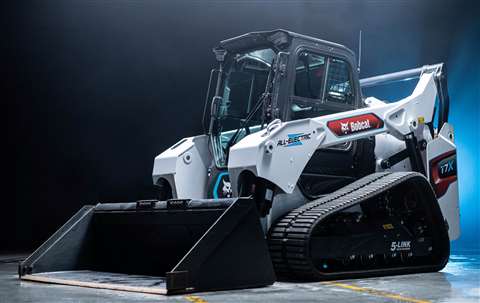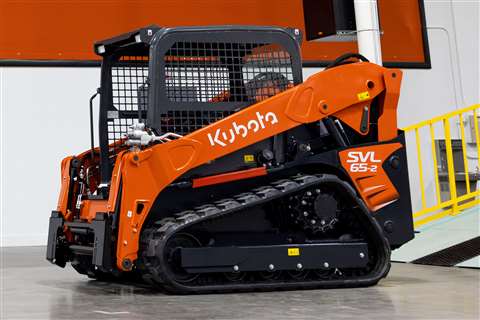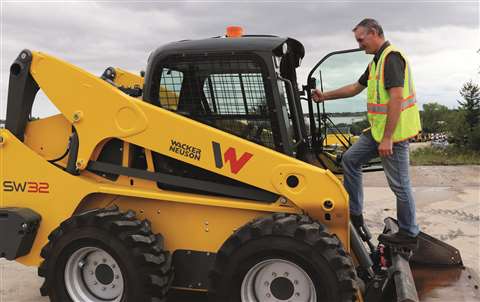Why are compact track loaders eating into skid steers’ market share in the US?
24 March 2023
The past decade has seen compact track loaders eat into the market share held by skid steer loaders in the US, before sales of the tracked machine overtook those of their wheeled counterparts completely.
 Bobcat’s award-winning T7X loader. (Photo: Bobcat)
Bobcat’s award-winning T7X loader. (Photo: Bobcat)
In 2012, there were 36,125 skid steer loaders sold in North America, compared to 21,500 sales of compact track loaders (CTLs). By 2022, that had leapt to 93,000 compact track loader sales, compared to 30,000 skid steer sales.
That meant that compact track loaders increased their share of sales from 37% among the two classes of machines a decade ago, to 76% in 2022, according to Off-Highway Research figures.
Skid steer loaders are a quintessentially American product, established by the Melroe Brothers, who later went on to become Bobcat, in the 1950s. As recently as the 1990s, they were to go-to compact construction machine in the US, with mini excavators not even in existence.
But over the last 5-10 years, compact track loaders, which at first glance look very similar to skid steers, have taken over, despite being more expensive to buy and maintain.
So what has caused the turnaround and why?
Ground conditions
Off-Highway Research managing director Chris Sleight explains that CTLs exert a lot less ground pressure, thanks to their tracks, allowing operators to in much poorer ground conditions.
 The new facility will help support demand for Kubota construction equipment in the U.S., starting with production of the Kubota SVL65 compact track loaders. (Photo: Great Plains Mfg.)
The new facility will help support demand for Kubota construction equipment in the U.S., starting with production of the Kubota SVL65 compact track loaders. (Photo: Great Plains Mfg.)
Meanwhile skid steer loaders, as their name implies, steer by braking on one side. While it makes them very manouevrable, it also means that they will easily churn up soft ground.
Sleight says, “CTLs can access more different types of ground conditions and if you are in an environment where you don’t want to damage the ground you have a lot of advantages of these lower-pressure tracks.”
The fact that they don’t disturb soft ground as readily opens CTLs up to more applications, such as landscaping on terrain that has already been established and needs to be maintained, Sleight notes.
Lower vibration
Tracked machines also generate less vibration than an operator would experience in a skid steer, with the tracked machine spreading out its contact point with the ground.
Sleight says, “Skid steers also used to sell in reasonable numbers in Europe but they don’t really now and part of that is down to the focus on whole-body vibration that started to come through 10-20 years ago.
“In a region like North America, the tracked loader is also a more comfortable machine to be buzzing about in during a shift, rather than skid steers.”
Skid steers still have a place
 Wacker Neuson’s SW32 skid steer features an All Access cab including easy entry, convenient step and ergonomically located handles
Wacker Neuson’s SW32 skid steer features an All Access cab including easy entry, convenient step and ergonomically located handles
But there are still certain situations where skid steers continue to hold an advantage over CTLs, which means that although their share of the market has declined, they are unlikely to disappear any time soon.
Sleight points to the fact that while a CTL will work on hard standing, for example, it will generate far more wear on the tracks, resulting in costly maintenance. Under such circumstances, a wheeled skid steer still makes more sense.
And as Off-Highway Research’s figures for machine sales in 2022 show, while the number of skid steers sold in 2022 is 20% lower than ten years previously, sales are still in the tens of thousands.
Backhoe loaders also see share decline
One other class of machine to have seen its share diminish in the US is the backhoe loader. “They still sell in quite good numbers but nothing like the numbers they used to,” says Sleight.
While backhoe loaders offer certain advantages, such as the fact that they can drive on roads rather than having to be towed on a trailer, their size has started to count against them.
“Although they are relatively manouevrable, typically in the UK you would see one lane closed in a road to lay a trench or pipe and it is a big machine to have parked there,” says Sleight.
Mini excavators have largely replaced backhoe loaders in Europe and despite the fact that sites are generally larger in the US, Sleight thinks the same thing has started to happen in North America. “If you are digging with a backhoe loader, you have only got one end, whereas with a mini excavator you can slew around, dig both ways and you have more flexibility. You are probably getting all the productivity you need out of a 3t mini excavator, which would generally be cheaper than a 9t backhoe loader,” he adds.
STAY CONNECTED



Receive the information you need when you need it through our world-leading magazines, newsletters and daily briefings.
CONNECT WITH THE TEAM








